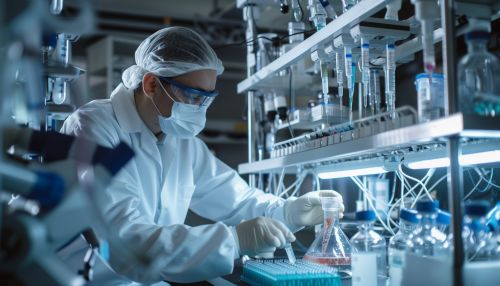Genetic modification
Introduction
Genetic modification (GM), also known as genetic engineering, refers to the direct manipulation of an organism's genes using biotechnology. It encompasses a range of techniques used to alter the genetic material of cells to produce new traits or enhance existing ones. This process involves the insertion, deletion, or modification of genes within an organism's genome. Genetic modification has applications in various fields, including agriculture, medicine, and industrial biotechnology.
Historical Background
The concept of genetic modification dates back to the early 20th century with the discovery of the structure of deoxyribonucleic acid by James Watson and Francis Crick in 1953. This breakthrough laid the foundation for modern genetic engineering. The first genetically modified organism (GMO) was created in 1973 by Herbert Boyer and Stanley Cohen, who inserted a gene from one bacterium into another, demonstrating that DNA could be transferred between organisms.
Techniques of Genetic Modification
Recombinant DNA Technology
Recombinant DNA technology involves combining DNA from different sources to create new genetic combinations. This technique uses restriction enzymes to cut DNA at specific sequences and ligases to join DNA fragments. The resulting recombinant DNA can be introduced into host cells, where it is replicated and expressed.
CRISPR-Cas9
Clustered Regularly Interspaced Short Palindromic Repeats-Cas9 is a revolutionary genome-editing tool that allows for precise, targeted changes to the DNA of living organisms. The CRISPR-Cas9 system uses a guide RNA to direct the Cas9 enzyme to a specific location in the genome, where it creates a double-strand break. This break can then be repaired by the cell's natural repair mechanisms, allowing for the insertion or deletion of genetic material.
Gene Silencing
Gene silencing techniques, such as RNA interference (RNAi) and antisense technology, are used to reduce or eliminate the expression of specific genes. RNAi involves the introduction of small interfering RNA (siRNA) molecules that bind to messenger RNA (mRNA) and prevent it from being translated into protein. Antisense technology uses synthetic strands of nucleic acids that are complementary to the target mRNA, blocking its translation.
Applications of Genetic Modification
Agriculture
Genetic modification has been widely adopted in agriculture to develop crops with desirable traits, such as pest resistance, herbicide tolerance, and improved nutritional content. Genetically modified crops, such as Bt cotton and Golden Rice, have been engineered to express specific traits that enhance their productivity and nutritional value.
Medicine
In medicine, genetic modification has led to the development of gene therapy, which involves the introduction of healthy genes into patients' cells to treat genetic disorders. Genetic engineering is also used to produce recombinant proteins, such as insulin and growth hormones, and to develop genetically modified organisms for research purposes.
Industrial Biotechnology
Genetic modification is used in industrial biotechnology to produce enzymes, biofuels, and other bioproducts. Microorganisms can be genetically engineered to produce enzymes that catalyze chemical reactions, improving the efficiency of industrial processes. Additionally, genetically modified algae and bacteria are being explored as sources of renewable biofuels.
Ethical and Regulatory Considerations
The use of genetic modification raises ethical and regulatory concerns, particularly regarding the safety and environmental impact of GMOs. Regulatory agencies, such as the Food and Drug Administration and the Environmental Protection Agency, oversee the approval and monitoring of genetically modified products to ensure their safety for human health and the environment. Ethical considerations include the potential for unintended consequences, the impact on biodiversity, and the socioeconomic implications of GMOs.
Future Prospects
The future of genetic modification holds great promise, with ongoing research aimed at developing new techniques and applications. Advances in genome editing, synthetic biology, and personalized medicine are expected to drive the next wave of innovation in genetic engineering. However, the continued development and adoption of genetic modification will require careful consideration of ethical, regulatory, and societal factors.


